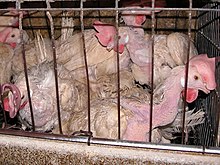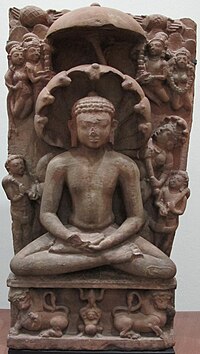

| Part of a series on |
| Animal rights |
|---|
| Rights |
|---|
 |
| Theoretical distinctions |
| Human rights |
| Rights by beneficiary |
| Other groups of rights |
|


Animal rights is the philosophy according to which many or all sentient animals have moral worth independent of their utility to humans, and that their most basic interests—such as avoiding suffering—should be afforded the same consideration as similar interests of human beings.[2] Broadly speaking, and particularly in popular discourse, the term "animal rights" is often used synonymously with "animal protection" or "animal liberation". More narrowly, "animal rights" refers to the idea that many animals have fundamental rights to be treated with respect as individuals—rights to life, liberty, and freedom from torture that may not be overridden by considerations of aggregate welfare.[3]
Many advocates of animal rights oppose the assignment of moral value and fundamental protections on the basis of species membership alone.[4] They consider this idea, known as speciesism, a prejudice as irrational as any other.[5] They maintain that animals should not be viewed as property or used as food, clothing, entertainment, or beasts of burden merely because they are not human.[6] Multiple cultural traditions around the world such as Jainism, Taoism, Hinduism, Buddhism, Shinto and Animism also espouse forms of animal rights.
In parallel to the debate about moral rights, law schools in North America now often teach animal law,[7] and several legal scholars, such as Steven M. Wise and Gary L. Francione, support the extension of basic legal rights and personhood to non-human animals. The animals most often considered in arguments for personhood are hominids. Some animal-rights academics support this because it would break the species barrier, but others oppose it because it predicates moral value on mental complexity rather than on sentience alone.[8] As of November 2019[update], 29 countries had enacted bans on hominoid experimentation; Argentina has granted captive orangutans basic human rights since 2014.[9] Outside of primates, animal-rights discussions most often address the status of mammals (compare charismatic megafauna). Other animals (considered less sentient) have gained less attention—insects relatively little[10] (outside Jainism) and animal-like bacteria hardly any.[11] The vast majority of animals have no legally recognised rights.[12]
Critics of animal rights argue that nonhuman animals are unable to enter into a social contract, and thus cannot have rights, a view summarised by the philosopher Roger Scruton, who writes that only humans have duties, and therefore only humans have rights.[13] Another argument, associated with the utilitarian tradition, maintains that animals may be used as resources so long as there is no unnecessary suffering;[14] animals may have some moral standing, but any interests they have may be overridden in cases of comparatively greater gains to aggregate welfare made possible by their use, though what counts as "necessary" suffering or a legitimate sacrifice of interests can vary considerably.[15] Certain forms of animal-rights activism, such as the destruction of fur farms and of animal laboratories by the Animal Liberation Front, have attracted criticism, including from within the animal-rights movement itself,[16] and prompted the U.S. Congress to enact laws, including the Animal Enterprise Terrorism Act, allowing the prosecution of this sort of activity as terrorism.[17]
- ^ Kumar, Satish (September 2002). You are, therefore I am: A declaration of dependence. Bloomsbury USA. ISBN 9781903998182.
- ^ DeGrazia (2002), ch. 2; Taylor (2009), ch. 1.
- ^ Taylor (2009), ch. 3.
- ^ Compare for example similar usage of the term in 1938: The American Biology Teacher. Vol. 53. National Association of Biology Teachers. 1938. p. 211. Retrieved 16 April 2021.
The foundation from which these behaviors spring is the ideology known as speciesism. Speciesism is deeply rooted in the widely-held belief that the human species is entitled to certain rights and privileges.
- ^ Horta (2010).
- ^ That a central goal of animal rights is to eliminate the property status of animals, see Sunstein (2004), p. 11ff.
- For speciesism and fundamental protections, see Waldau (2011).
- For food, clothing, research subjects or entertainment, see Francione (1995), p. 17.
- ^ "Animal Law Courses". Animal Legal Defense Fund. Archived from the original on 2020-12-04. Retrieved 2020-12-13.
- ^ For animal-law courses in North America, see "Animal law courses" Archived 2010-06-13 at the Wayback Machine, Animal Legal Defense Fund. Retrieved July 12, 2012.
- For a discussion of animals and personhood, see Wise (2000), pp. 4, 59, 248ff; Wise (2004); Posner (2004); Wise (2007) Archived 2008-06-14 at the Wayback Machine.
- For the arguments and counter-arguments about awarding personhood only to great apes, see Garner (2005), p. 22.
- Also see Sunstein, Cass R. (February 20, 2000). "The Chimps' Day in Court" Archived 2017-05-01 at the Wayback Machine, The New York Times.
- ^ Giménez, Emiliano (January 4, 2015). "Argentine orangutan granted unprecedented legal rights". edition.cnn.com. CNN Espanol. Archived from the original on April 3, 2021. Retrieved April 21, 2015.
- ^
Cohen, Carl; Regan, Tom (2001). The Animal Rights Debate. Point/Counterpoint: Philosophers Debate Contemporary Issues Series. Lanham, Maryland: Rowman & Littlefield Publishers. p. 47. ISBN 9780847696628. Retrieved 16 April 2021.
Too often overlooked in the animal world, according to Sapontzis, are insects that have interests, and therefore rights.
- ^
The concept of "bacteria rights" can appear coupled with disdain or irony:
Pluhar, Evelyn B. (1995). "Human "superiority" and the argument from marginal cases". Beyond Prejudice: The Moral Significance of Human and Nonhuman Animals. Book collections on Project MUSE. Durham, North Carolina: Duke University Press. p. 9. ISBN 9780822316480. Retrieved 16 April 2021.
For example, in an editorial entitled 'Animal Rights Nonsense,' ... in the prestigious science journal Nature, defenders of animal rights are accused of being committed to the absurdity of 'bacteria rights.'
- ^ Jakopovich, Daniel (2021). "The UK's Animal Welfare (Sentience) Bill Excludes the Vast Majority of Animals: Why We Must Expand Our Moral Circle to Include Invertebrates". Animals & Society Research Initiative, University of Victoria, Canada. Archived from the original on 2022-11-29. Retrieved 2022-06-18.
- ^ Cite error: The named reference
Scrutonwas invoked but never defined (see the help page). - ^ Liguori, G.; et al. (2017). "Ethical Issues in the Use of Animal Models for Tissue Engineering: Reflections on Legal Aspects, Moral Theory, 3Rs Strategies, and Harm-Benefit Analysis" (PDF). Tissue Engineering Part C: Methods. 23 (12): 850–862. doi:10.1089/ten.TEC.2017.0189. PMID 28756735. S2CID 206268293. Archived (PDF) from the original on 2020-09-15. Retrieved 2019-07-12.
- ^ Garner (2005), pp. 11, 16.
- Also see Frey (1980); and for a review of Frey, see Sprigge (1981) Archived 2016-02-19 at the Wayback Machine.
- ^ Singer (2000), pp. 151–156.
- ^ Martin, Gus (15 June 2011). The SAGE Encyclopedia of Terrorism, Second Edition. SAGE. ISBN 9781412980166 – via Google Books.